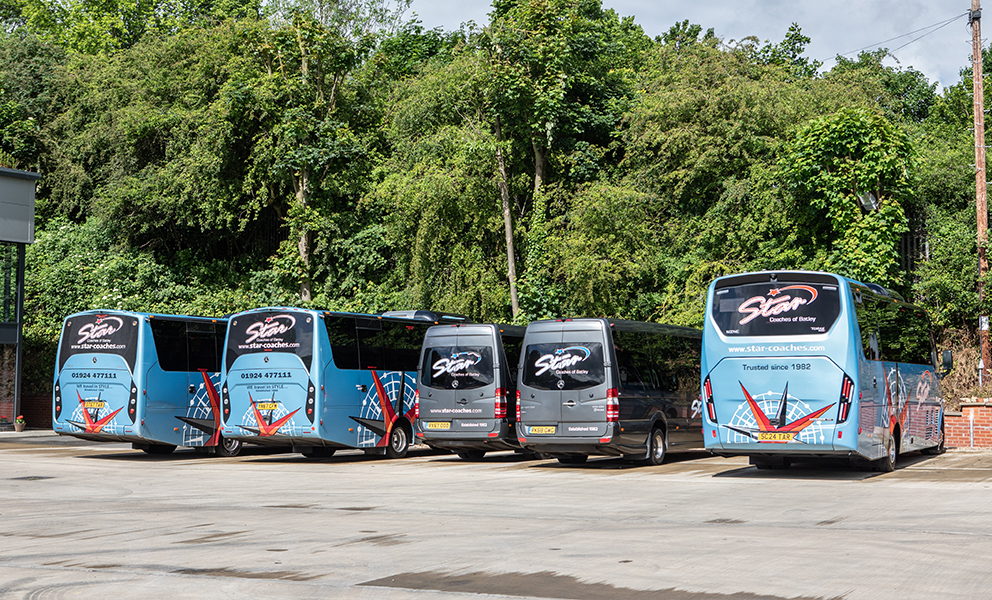What Class Is a 16 Seater Minibus? Explained
Learn everything about 16-seater minibus classification, D1 licence rules, insurance types, MOT and tax requirements for UK drivers and operators.
Understanding Minibus Classifications
What Does Vehicle Class Mean?
In the UK, vehicle classification refers to how the DVLA categorizes vehicles based on size, weight, passenger capacity, and intended use. These classifications determine everything from:
- Licence requirements
- Insurance brackets
- Road tax obligations
- MOT and safety standards
Understanding the class of a minibus isn’t just a formality—it shapes legal responsibilities, operational costs, and who can legally drive it.
Why Classification Matters for Drivers and Owners
If you're operating a 16-seater minibus for personal or commercial reasons—like school trips, airport transfers, or charitable transport—it’s essential to know:
- Whether you or your staff need a special licence (e.g. D1)
- If you’ll require tacho equipment and operator licences
- What kind of insurance is legally acceptable
What Class Is a 16 Seater Minibus?
The Official Vehicle Class for a 16 Seater Minibus
According to the DVLA, a 16 seater minibus is typically classed as a Category D1 vehicle, which covers minibuses with:
- More than 8 but fewer than 17 passenger seats
- A maximum length of 8 metres
This classification places it between a standard car (Category B) and full-size bus or coach (Category D).
Is a 16 Seater Minibus a D1 Category Vehicle?
Yes — under most conditions, a 16 seater falls neatly into the D1 category. However, there are exceptions depending on:
- The date your driving licence was issued
- Whether the minibus is used for commercial purposes
- The age and medical status of the driver
Who Can Legally Drive a 16 Seater Minibus?
Driving Licence Categories Explained
To legally drive a 16-seater minibus in the UK, you need to understand a few key licence categories:
| Licence Category | What It Allows | Common For |
| Category B | Standard car (up to 8 passenger seats) | Most drivers |
| Category D1 | Minibuses with 9–16 passenger seats | Minibus drivers (non-commercial and some commercial) |
| Category D | Any bus with more than 8 seats (including full-size coaches) | Bus/coach drivers |
Do You Need a Special Licence to Drive a 16 Seater?
That depends on when you got your driving licence and how the minibus will be used:
- Issued before 1 January 1997 You likely have D1 entitlement on your licence. ✅ You can drive a 16-seater non-commercially without extra tests.
- Issued after 1 January 1997 You may not have D1 by default. ❌ You’ll need to apply for a D1 provisional and pass both medical and theory/practical tests.
- Commercial Use? Even if you have D1, driving for hire or reward (like paid group travel) generally requires:
- A full D1 licence
- A Driver Certificate of Professional Competence (CPC)
- Possibly a PSV operator’s licence
Penalty Risks
Driving a 16-seater without proper entitlement can result in:
- Hefty fines
- Licence points
- Voided insurance
So it’s crucial to double-check your licence codes and vehicle use scenario.
DVLA Rules for Driving a 16 Seater Minibus
UK Government Guidelines You Need to Know
The Driver and Vehicle Licensing Agency (DVLA) sets out strict rules on who can legally drive a 16-seater minibus. Here are the core requirements:
- 🔸 Must be at least 21 years old
- 🔸 Hold a valid Category D1 licence (full or restricted)
- 🔸 Driving must not be for hire or reward, unless the driver has a Driver CPC and proper operator licensing
- 🔸 The minibus must meet roadworthiness and safety standards
For organisations operating under a Section 19 permit (e.g. schools or charities), drivers may be exempt from certain operator licensing rules, but licence and health standards still apply.
Age and Medical Requirements for Drivers
Depending on the licence type and usage, medical conditions can affect eligibility. Here's how:
| Driver Type | Age Limit | Medical Requirements |
| Standard D1 Driver | Minimum 21 | Group 2 medical every 5 years after age 45 |
| Drivers Over 70 | Must renew licence every 3 years | Must meet Group 2 medical standards |
| Volunteer Drivers (e.g. for charities) | 21 or older | Must meet the health conditions for Group 2 and have held Category B licence for 2+ years |
When Can You Drive a 16 Seater Minibus on a Car Licence?
Licence Rules for Non-Commercial Use
If you only have a Category B (car) licence, you may be permitted to drive a 16-seater minibus if all the following conditions are met:
- You're driving the minibus on a voluntary basis
- The use is non-commercial (e.g. community group, school, charity)
- You’re at least 21 years old, but under 70
- You’ve held your Category B licence for at least 2 years
- The minibus:
- Weighs no more than 3.5 tonnes (or 4.25 tonnes if adapted for disability access)
- Is not towing a trailer
Conditions That Allow Driving Without D1 Entitlement
This exemption is part of a special arrangement for community transport, often tied to a Section 19 permit. Here's how it typically plays out:
| Scenario | D1 Required? | Notes |
| Driving for a charity or school trip (no payment) | ❌ No | If all conditions above are met |
| Taking passengers on a paid group tour | ✅ Yes | Commercial use, not eligible |
| Volunteering with a faith-based organisation | ❌ No | As long as it's not for hire/reward |
D1 Licence: What It Covers and How to Get It
What Is the D1 Licence Category?
The D1 category licence allows drivers to operate minibuses with:
- 9 to 16 passenger seats
- A length of up to 8 metres
- Optional trailers up to 750kg
It’s ideal for driving 16-seaters for hire or reward, such as professional transport services, private hire, school contracts, or tour operations.
Steps to Apply and Pass the D1 Driving Test
If your current driving licence lacks D1, here’s how to obtain it:
- Apply for a D1 Provisional Entitlement
- Fill out form D2 (available from the DVLA or post office)
- Get a Group 2 medical exam using form D4, completed by a doctor
- Book and Pass the D1 Theory Test
- Includes:
- Multiple choice questions
- Hazard perception test
- Includes:
- Take the Practical Driving Test
- Conducted in a Category D1 vehicle
- Includes:
- Vehicle safety questions
- Off-road and on-road driving skills
- Reversing manoeuvres and independent driving
- Add the Entitlement to Your Licence
- Once passed, D1 will appear on your photocard along with relevant expiry dates
Insurance Implications for 16 Seater Minibuses
What Insurance Class Does It Fall Under?
A 16-seater minibus does not fall under standard car insurance. Instead, it typically requires:
- Minibus Insurance (Class 5 or 6) Designed for vehicles carrying multiple passengers, especially for public, private, or community transport.
- Additional cover might include:
- Public liability insurance
- Breakdown cover
- Legal protection
The exact class depends on:
- Who owns the minibus
- Who’s driving it (volunteer or employee)
- Whether money changes hands
Private vs Commercial Use: Insurance Differences
| Use Type | Insurance Type | Key Features |
| Private Use | Private minibus insurance | For personal trips like family or group travel (rare for 16-seaters) |
| Charity/Community Use | Charity minibus cover or Section 19 permit insurance | Often includes volunteer driver cover, non-profit use |
| Commercial Use | Hire & reward or business motor insurance | Required if transporting passengers for payment (e.g. school contracts, airport runs) |
16 Seater Minibus Use Cases
School Runs, Charity Trips and Group Travel
16-seaters are a sweet spot for mid-size groups — large enough to carry full teams or classrooms, but compact enough for flexibility and maneuverability. Here are the most common non-commercial applications:
- School Transport
- Daily school pickups and drop-offs
- Field trips and sports fixtures
- Charity and Volunteer Groups
- Accessible transport for the elderly or disabled
- Church outings, community centre trips
- Local Councils & Youth Programs
- Weekend excursions or educational visits
- Subsidised transport under Section 19 permits
Business and Commercial Use Scenarios
For businesses, hiring or owning a 16-seater can reduce cost per passenger while offering comfort and professional presentation. Common commercial use cases include:
- Airport Transfers
- Ideal for transporting teams, tourists, or VIP clients with luggage space to spare
- Event Transport
- Weddings, corporate retreats, and private parties
- Tourism Operators
- Local sightseeing, inter-city travel, or bespoke guided tours
- Contracted Shuttle Services
- Staff transport, industrial zones, or university routes
Safety Rules and Legal Responsibilities
Seatbelts, Load Limits and Safety Equipment
Operating a 16-seater comes with strict requirements for passenger safety. Key points include:
- Seatbelts:
- Must be fitted for every seat used to carry passengers
- Drivers are responsible for under-14 passengers wearing them
- Over-14s are responsible for themselves, but enforcement is still encouraged
- Load Limits:
- Adhere to the manufacturer’s maximum weight
- Overloading can lead to mechanical issues, fines, and insurance nullification
- Emergency Exits & Signage:
- Exits must be clearly marked, unobstructed, and functional
- Fire extinguishers and first aid kits are mandatory in many operating scenarios
- Driver Visibility & Access:
- Clear mirrors and glass
- No obstructions near driver’s controls or vision points
Regular Maintenance and Vehicle Checks
Routine inspections are the foundation of safety. You’ll need to ensure:
| Check Type | Frequency | What’s Included |
| Daily Walkaround Checks | Before each use | Tyres, lights, wipers, horn, mirrors, brakes, leaks |
| Scheduled Servicing | Per manufacturer | Engine, suspension, exhaust, steering systems |
| MOT (Ministry of Transport Test) | Annually | Legally required once the vehicle is over 1 year old |
Tachograph and Driver Hours for 16 Seaters
When You Need a Tachograph
A tachograph is a device that records driving time, speed, and rest periods. Whether you need one depends on how the minibus is used:
- Required if:
- The minibus is used for hire or reward
- It’s driven outside the UK
- It’s part of a commercial operation (e.g. airport transfers, tours)
- The vehicle is subject to EU or AETR rules (typically if it has 10+ seats and is used commercially)
- Not required if:
- The minibus is used non-commercially (e.g. school, charity, volunteer work)
- It operates within the UK under GB domestic rules
- It’s covered by a Section 19 or 22 permit
Driver Working Hours and Rest Periods
If your 16-seater falls under EU or AETR rules, here’s what drivers must follow2:
| Rule Type | Requirement |
| Daily Driving Limit | Max 9 hours (can extend to 10 hours twice a week) |
| Weekly Driving Limit | Max 56 hours |
| Fortnightly Limit | Max 90 hours over any 2 consecutive weeks |
| Breaks | At least 45 minutes after 4.5 hours of driving (can be split into 15 + 30 mins) |
| Daily Rest | Minimum 11 hours (can reduce to 9 hours 3 times per week) |
| Weekly Rest | Minimum 45 hours, reduced to 24 hours every other week with compensation |
For GB domestic rules (non-commercial use), the limits are slightly different:
- Max 10 hours driving per day
- Max 11 hours duty time
- Rest: 10 hours between shifts (can reduce to 8.5 hours up to 3 times a week)
Vehicle Tax and MOT for 16 Seater Minibuses
Tax Class Breakdown for Minibuses
In the UK, a 16-seater minibus is typically taxed under the “Bus” taxation class if it has 9 or more passenger seats. Here’s how it breaks down:
- Private Minibus (Non-Commercial Use)
- Taxed as a Private HGV or Bus
- Annual tax is not CO₂-based, unlike cars
- Rates vary depending on weight and emissions class
- Commercial Minibus (For Hire or Reward)
- Taxed as a Public Service Vehicle (PSV)
- Requires operator licensing and may be subject to additional levies
MOT Frequency and What It Covers
Minibuses must undergo annual MOT testing starting one year after first registration. The MOT ensures the vehicle meets road safety and environmental standards.
| MOT Requirement | Details |
| Frequency | Every 12 months after the first year |
| Test Class | Class V (for minibuses with 13–16 passenger seats) |
| Covers | Brakes, lights, tyres, emissions, seatbelts, steering, suspension, and more |
| Where to Test | Must be tested at a Class V-approved MOT centre |
Final Thoughts
Understanding the legal class, licensing rules, and operational obligations for a 16-seater minibus isn’t just red tape — it’s the foundation of safe, lawful, and stress-free travel. Whether you're a school administrator, charity coordinator, or transport operator, here’s what matters most:
- A 16-seater minibus typically falls under the D1 vehicle category
- You may be able to drive one on a standard car licence — but only under very specific non-commercial conditions
- For commercial or hire/reward use, you’ll likely need D1+Driver CPC, proper insurance, and possibly a tachograph
- Compliance with DVLA safety regulations, tax, MOT, and maintenance standards is essential
- Your choice to buy or lease depends on budget, frequency of use, and long-term plans
Frequently Asked Questions
Can You Drive a 16 Seater Minibus Abroad?
Yes, but you’ll need to ensure:
- Your D1 licence is valid in the country you’re visiting
- The minibus is insured for international travel
- You carry the VE103B certificate (if it’s a leased or hired vehicle)
- You comply with EU tachograph and driver hour rules if driving commercially
What’s the Difference Between 9, 12 and 16 Seaters?
| Vehicle Size | Seats | Ideal For | Licence Needed |
| 9 Seater | 8 passengers + driver | Small family or team trips | Category B |
| 12 Seater | 11 passengers + driver | Medium-sized groups | Often requires D1 |
| 16 Seater | 15 passengers + driver | Schools, events, tours | D1 or exemption |
Is a 16 Seater Considered a Bus or a Van?
Technically, it’s classified as a minibus — a subcategory of bus under DVLA rules. It’s not a van, even though it may resemble one in size. Key distinctions:
- Bus: Designed to carry passengers (9+ seats)
- Van: Designed for goods, not passengers
So, a 16-seater is a bus for licensing, tax, and insurance purposes, not a van.
Can I Drive a 16 Seater Minibus Without a CPC?
Yes — but only in specific cases. The Driver Certificate of Professional Competence (CPC) is required if you're:
- Driving commercially (for hire or reward)
- Operating as part of a business or transport company
- Driving outside the UK under EU rules
You don’t need a CPC if:
- You're driving non-commercially (e.g. school, charity, or community group)
- You're a volunteer and meet the DVLA exemption criteria
- You're not receiving payment beyond expenses
What Happens If I Drive a 16 Seater Without the Right Licence?
Driving without the correct entitlement (e.g. D1 or CPC) can lead to:
- Fines up to £1,000
- Penalty points or disqualification
- Invalidated insurance
- Legal prosecution for operating without proper authority



